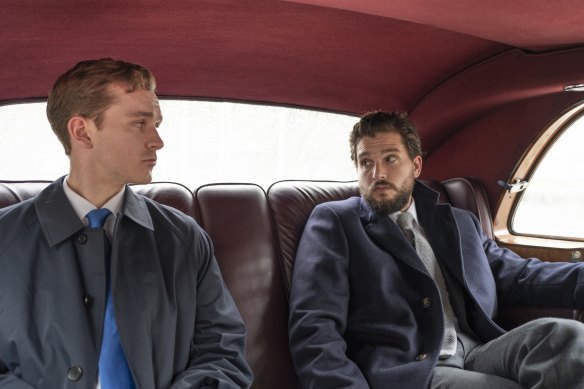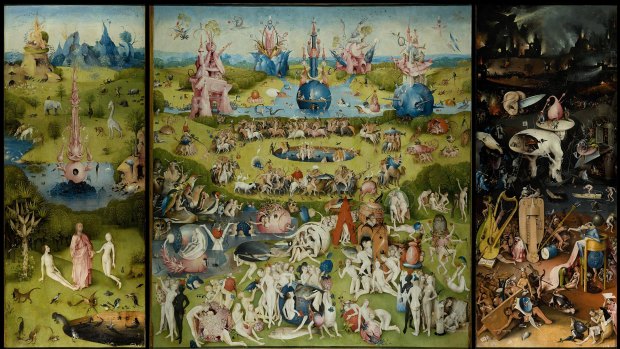Warning: This article contains spoilers for the HBO show Industry.
Shorts and sneakers may be a common sight in the relaxed world of post-COVID office dressing, but you wouldn’t know it from watching an episode of Industry, where image is everything.
The hit HBO show, now in its third season, follows a group of ambitious graduates vying for success in the world of finance.

The style evolution of Harper Stern, from season one to three.Credit: HBO
Mickey Down, the show’s co-creator who drew from his former life in the finance world, has spoken about the importance of fashion in crafting the Industry universe, telling Gentleman’s Journal, “I had visions of Hermès ties and nice suits.” The show’s fashion follows a rich legacy of bankers on screen, from Gordon Gekko to Patrick Bateman and Jordan Belfort.
“It’s really fascinating how powerful that image of the banker is, and how much it affects people’s dress still,” says Laura Smith, a London-based costume designer who came on board for the latest season.
And while much of the finance talk on the show may go over most people’s heads, fashion – as something tangible and immediate – is a powerful narrative touchpoint.
Take, for example, actor Myha’la’s character Harper Stern. The merciless American transplant with a penchant for insider trading is chameleon-like in her style.
In season one, she arrives in London with the sole purpose of seeking her fortune at Pierpoint. By season three, she’s been ousted from the fictional bank and finds herself working as a PA at an ethical investment fund. No longer bound by the banking world’s strict dress code, Harper’s dress is more casual, anchored by loose shirts and soft knits.
“We talked about designing her clothes in a way that she maybe experienced the city completely differently,” explains Smith. “Because in London, you can spot bankers very quickly, and this doesn’t always have positive connotations, and it means you can’t always gain access to certain places.”
“I mean, she’s young, she wants to go out … so it was really thinking about ways that she could look like she was able to go from day to night.”
Smith says Harper, ever the opportunist, emulates things from the world around her. In the first couple of seasons, it may have been a coat from her wealthy friend Yasmin or a crisp shirt from her mentor Eric. This season, it’s her stylish mentor Petra. Smith gave her a rare pearl necklace from designer Melanie Georgacopoulos.
“Harper takes cues from them about how they navigate the world stylistically – what things matter to them or don’t. And Petra makes a comment about liking nice things and not being ashamed of it. And this is the first time, really, that Harper has been able to do that.”
Wealth may be everywhere in the world of Industry, but class is what really counts. Having money is one thing. But are they new money or old money? Is their money loud or quiet? And in the UK, where Industry is set, class is, arguably, more deeply ingrained than anywhere else in the world.
“You read very quickly what kind of social class people come from or can make a fairly good guess by what they’re wearing,” says Smith.

Robert Spearing (Harry Lawtey) and Sir Henry Muck (Kit Harington) in season 3 of Industry.
For Robert Spearing, the handsome but troubled state-school graduate played by Harry Lawtey, dress is an integral part of how he’s received in the banking world.
In season one, he’s teased for having studied geography at Oxford (another layer of intellectual snobbery) and has the pocket ripped off his cheap suit by co-workers. In this new season, we find Robert helming the relationship with Lumi, a green-energy start-up that Pierpoint is taking public.
“In terms of clothing, Robert’s the character who suffers the most with that scrutiny. [But] he really comes into his own in this season,” says Smith.
On the cusp of Lumi’s stock exchange debut, Robert dresses the part, donning a blue Hermès tie.
“This is kind of the apex moment of his career,” says Smith. “But it doesn’t quite turn out like that because as soon as Industry blows up that balloon, the pin is there to puncture it.”
It’s an anticipatory, aspirational way of dressing that’s rendered all the more tragic when his dreams are dashed.
“We thought about that a lot with the actors – would this be what they choose to wear for where they want to go, rather than where they are now? – because that’s a lot of what this season of Industry is,” explains Smith.

Harper Stern, played by Myha’la, sheds the corporate suiting in season three.
By contrast, Sir Henry Muck, the old money start-up founder of Lumi, portrayed by Kit Harrington, is already where he wants to be. He has what Smith calls a “Johnsonian” approach to dressing, referring to the former UK prime minister Boris Johnson and his dishevelled styling of expensive suits.
“This is one of the things about class in the UK,” says Smith. “A middle-class person will dress very smartly, whereas a very wealthy person will not necessarily feel the need to because they don’t have to.”

Marisa Abela as Yasmin in Industry, season three, on board The Lady Yasmin.Credit: HBO
In the Pierpoint boardroom, suited employees may seem no different from one another, but Smith points out subtle differences in her design choices. Floor manager Eric Tao, like Robert, is self-made, and wears ties from Hermès, an infamous luxury brand and household name.
Henry, on the other hand, wears ties from E.Marinella, a Neapolitan company with a store in London’s exclusive Burlington Arcade.
“All of those things were very particular stylistic choices you made to locate those people in an unspoken hierarchy. If you frequent those places, you understand the language of those items.”

Hieronymus Bosch’s Garden of Earthly Delights was a metaphor for the season.
Anchoring her stylistic choices this season was a painting, says Smith. Throughout the season we see flashbacks to publishing heiress Yasmin Kara-Hanani’s summer spent on her namesake yacht, The Lady Yasmin, from which her father mysteriously disappears.
“There was one line in the very first script which was about the boat [The Lady Yasmin] being a Hieronymus Bosch painting,” she says, referring to the Dutch painter’s famous Garden of Earthly Delights. The triptych depicts scenes drawn from faith and history – God presenting Eve to Adam, the orgiastic garden of earthly delights, and hell.
In the opening moments of the season’s first episode, we catch a glimpse of an extra wearing a set Smith had custom-made, printed with Bosch’s work. And throughout the season, Smith says she chose to emulate the colour palette of the triptych in many of the crowd scenes.
“When the floor goes into meltdown in episodes seven and eight, it’s that again, because that’s what that painting is. It’s like a sort orgiastic madness.”
Make the most of your health, relationships, fitness and nutrition with our Live Well newsletter. Get it in your inbox every Monday.